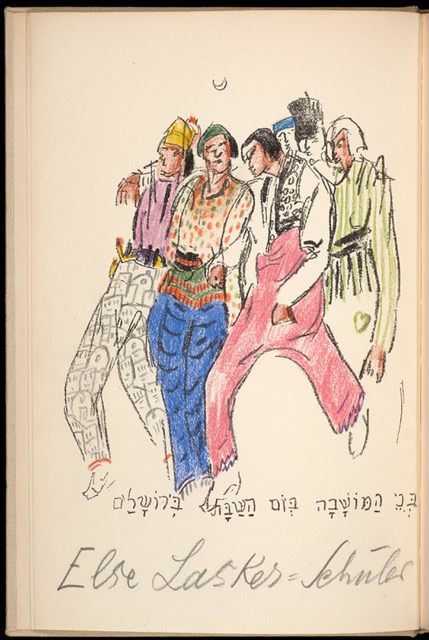Deluxe edition with 8 illustrations, of these one fully hand-coloured in colour crayon and signed by the artist. Size: 23 x 16 cm. 168 p. Published by Oprecht, Zurich. Edition: 80 on deluxe paper.
Literature: Sternfeld-Tiedemann 192.
Provenance: Hugo May (1887-1958, Zurich) (given by the author).
Very fine and fresh page, hand-coloured by the artist.
In 1933, the German-Jewish poet Else Lasker Schüler was exiled to Zurich. To make a living in some way, she filed a request with the Swiss authorities to be permitted to gift pictures to people who supported her financially. The immigration authorities, however, declined her request, arguing that “this would be the same as working”. To make things worse, they came to the humiliating conclusion: “The continuation of the petitioner’s stay is neither necessary nor desired and we apply for the denial of a residence permit.”
This meant, Lasker-Schüler was being rejected to work as a poet and artist in Switzerland at the same time as having her work listed in the Nazi index of banned literature. “The Banished” is the fitting title of one of her poems written in exile.
It was only thanks to the help of loyal friends and supporters that Lasker-Schüler managed to remain in Switzerland until 1939, despite the difficulties she faced by immigration authorities. Among notable supporters was Emil Oprecht, the publisher and president of the board of directors of the Zurich Schauspielhaus theatre, who published her travelogue “Das Hebräerland” (Land of the Hebrews) and Hugo may (1887-1958), the director of the Zurich department store Julius Brann, had a great interest in the arts and philosophy. He met Else Lasker-Schüler in early 1934. They were probably introduced to each other by May’s colleague Kurt Ittmann, a fellow member of the Brann department store’s board of management, who had been in contact with the poet since July 1933.
Ittmann and May, as well as Sylvian Guggenheim, the owner of a silk factory and the president of the Swiss Israelite Poor Relief, belonged to the Zurich circle who financially supported Lasker-Schüler. The two Brann directors safeguarded her existence with a monthly stipend of 100 Swiss Franks from mid-1934 onwards, and also secured a residence permit. They both stood surety for her as guarantors at the immigration authorities to protect her from repeated threats of expulsion, in November 1934 and again in November 1935.
Contrary to accounts that painted an image of the artist as a resigned and confused exile, Lasker-Schüler confronted the difficulties of life in exile within her artistic work and in attempts to make a living independently. Art thus became for her a means of addressing and answering the sense of shame that came with being resigned to the status of alms recipient, which Lasker-Schüler addresses towards May and Ittmann in April 1936: “I find it and everyone finds it, / especially as the fall into hardship is so severe,/infinitely gentle of you,/ and of you both so noble!/ How can I atone for it all?”
